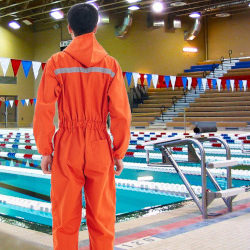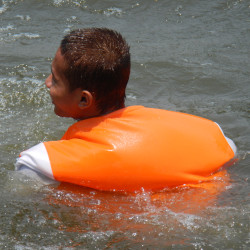History of the Overall
The 1989 edition of the Oxford English Dictionary lists the word boilersuit first on 28 October 1928 in the Sunday Express newspaper. Japanese politicians have been known to use boilersuits to convey an image of preparedness.
Boilersuits
So called because they were first worn by men maintaining coal-fired boilers. To check for steam leaks or to clean accumulated soot from inside the firebox of a steam locomotive, someone had to climb inside, through the firehole (where the coal is shovelled in).
A one-piece suit avoids the potential problem of loosened soot entering the lower half of one's clothing through the gap in the middle. As the firehole opening is only just large enough for a fit individual to negotiate, a one-piece suit also avoids the problem of the waistband snagging on the firehole as one bends to wriggle through, or of jacket tails snagging if one has to come out backwards.
Nomex
Overalls made of Nomex in olive drab (and more recently, desert tan) are used by the military as flight suits.
They are form fitting coveralls with many zippered pockets, originally made of cotton treated for flame resistance,
but now made of Nomex, a flame-resistant meta-aramid material developed in the early 1960s by DuPont and first marketed in 1967.
Tuta
The Tuta is the Italian coverall version by designer Thayaht, which he called "the most innovative, futuristic garment ever produced in the history of Italian fashion". It was an early example of what are now known as coveralls, intended to revolutionise fashion and create a modern and particularly Italian style.
With help from his artist brother RAM (Ruggero Alfredo Michahelles) he launched the new design in 1920, and the pattern was published by the newspaper "La Nazione" so that the TuTa became accessible to all. Intended as a practical item of clothing for everyday activities, it was instead adopted as a fad by high Florentine society.


Finnish Student Overalls
Overalls called "student boilersuits" are used by university students in some Nordic countries as a sort of party-uniform, especially for pool parties, with insignia on the back and colour varying with programme and university.
Overalls are a huge part of Finnish student tradition and you can see students all around the city wearing overalls in different coulours. Different faculties and subject organizations at the university have their own colours.
Students get overall patches from parties and events that they participate in and sew them onto their overalls, so no two overalls look exactly the same.
There are some national events where all students wear their overalls, the most important ones being Laskiainen in February and Vappu (the biggest student event of the year) in May.
Different student associations also have their own overall parties during the year, pool parties being the most popular.
There are some traditions connected with overalls, such as never washing them.
You're only allowed to wash it if you're wearing it,
hence the pool parties which may start with a big soap lathering in the showers.